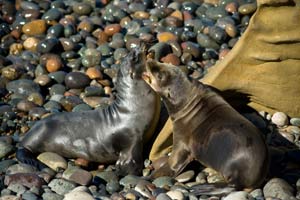

  |
|
List of "In the Spotlight" Features ACES Announces Exciting New Partnership
Have you ever wondered what kind of cool and weird creatures live in the ocean? Well, scientists around the world wonder the same thing! In fact, scientists from over 80 nations around the world are working on many projects to find out about our ocean's biodiversity. This huge, ten year program is known as the 'Census of Marine Life'.
One project within the 'Census' is the TOPP (Tagging of Pacific Predators) Project. TOPP Scientists are using satellite tracking to learn about the behavior of large animals in the Pacific Ocean, and are working with Signals of Spring - ACES to bring their data to students. Two interesting species being studied by TOPP scientists are the Northern Elephant Seal and California Sea Lion. Both of these animals are common in West Coast waters, and can often be seen lounging on the shorelines. Of course, all marine mammals are protected by the Marine Mammal Protection Act, and are wild animals. Even though they look cute and friendly, they are wild animals, and you should never approach them! Scientists know a lot about these pinnipeds' behaviors onshore, but are not really able to follow them out to sea. So, the satellite tags do that for them. Some of these animals travel way out into the North Pacific, into areas that haven't been extensively explored by ships carrying measuring instruments. The seals and sea lions, however, can carry instruments within their satellite tags. When the animals dive to get food, instruments on their tags record things such as water temperature, salinity, and light levels. In a lot of cases, this is brand new information.  Samantha Simmons is a graduate student at the University of California at Santa Cruz, and a scientist with the TOPP project studying these animals. She explains, "This is like a partnership with the animals; we are learning more about the environment at the same time as we are learning about the behavior of the animals. I think that's kind of cool!"
Samantha Simmons is a graduate student at the University of California at Santa Cruz, and a scientist with the TOPP project studying these animals. She explains, "This is like a partnership with the animals; we are learning more about the environment at the same time as we are learning about the behavior of the animals. I think that's kind of cool!"
The information, or data, being collected by the animals is really important. It can help scientists understand how the ocean is changing as our climate warms, and also how the animals respond to environmental changes. |
| Sponsored by: | |
 | National Aeronautics and Space Administration (NASA Award NCC5433) |
 | National Oceanic & Atmospheric Administration (NOAA Award NA06SEC4690006) |
Copyright © 2025 U.S. Satellite Laboratory, Inc. All rights reserved.